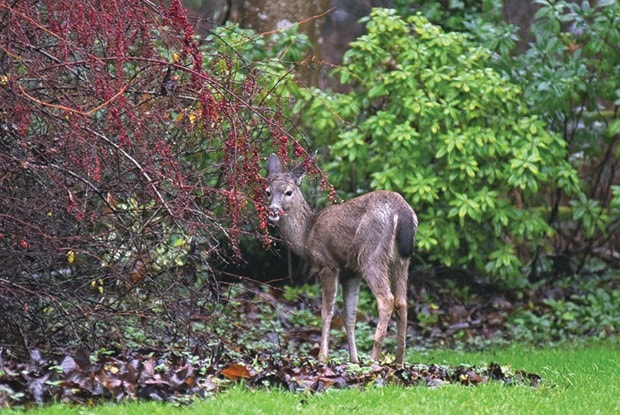A meeting on the Mainland about deer management last week confirmed many things for Oak Bay Mayor Nils Jensen.
“We certainly heard we weren’t the only ones in British Columbia with problems of overpopulation of deer,” he said.
The meeting confirmed for him that relocation and contraception were not options and culls in the East Kootenay were successful.
Oak Bay applied, through the Regional Deer Management Strategy pilot project, to the Ministry of Forests, Lands and Natural Resource Operations for a permit to proceed with a cull of 25 deer in Oak Bay this year.
Jensen and district staff heard from other communities about similar deer/human conflict situations such as vehicle collisions as well as disease from feces and ticks.
“The ministry outlined all of the options that have been used elsewhere and are possible. Really it came down to the only option available to reduce population is culling,” Jensen said. “It confirmed what we heard through the CRD process and through other experts.”
While the permit had yet to be approved as of Monday, a contractor has been identified through an RFP process and would be trained. If granted, the permit would determine the process including time frame, which could run into March, Jensen said.
“Just because you get a permit doesn’t mean you use it,” says resident Kristy Kilpatrick. “Show leadership. We’ve got a better option here. I’m going to be optimistic and believe they will do the right thing.”
Kilpatrick calls processes put in place by Oak Bay to reduce deer/human conflict “perfunctory”. Those include the deer count, signage and education as well as a lack of public consensus.
The Oak Bay resident also wants to reprise the profile of the immunocontraceptive SpayVac as an option.
Saanich biologist Rick Page has worked with Mark Fraker, a biologist and president of SpayVac for Wildlife Inc. and TerraMar Environmental Research based in Sidney. SpayVac is considered experimental as it has not been widely used. However, Fraker has used it in the United States and locally, at CFB Esquimalt and Maple Ridge, with positive results, according to Page.
“This is an opportunity for Oak Bay to do an incredible pilot project that I think people would buy into and support,” Kilpatrick said. “What Rick [Page] offers is an effective, long-term, humane solution. … I think it would meet with the values of the majority of the Oak Bay population.”
SpayVac has long been part of the cull conversation, and approval must be granted by Health Canada and the province’s wildlife veterinarian to use it.
Page said it likely comes down to cost. A full pilot project with trained biologists would run in the range of $200,000 he said.
“We suggest $50,000 for a pilot project,” Page said, adding Brian Starzomski, assistant professor at UVic’s School of Environmental Studies, and instructor Jason Fisher are interested in a pilot vaccination research project.
A SpayVac project would still include trapping female deer in clover traps – using cameras to specifically trap does. They would get a needle, an ear tag and be released. Ideally the deer is vaccinated against pregnancy for life, and monitored via the ear tag to ensure the contraception is working.
“I think it would be an amazing thing to be a leader in this issue and to bring down the emotional level,” Kilpatrick said.
Jensen notes the pilot project is not associated with a research project, but is a program to reduce deer population.
“At the workshop in Vancouver, in the presentation by the B.C. wildlife veterinarian, we were told contraceptive immunization, SpayVac itself is not being produced,” Jensen said. “Even if it were being produced, because it’s an experimental drug it cannot be used in a program. It can only be used for a research program.
“If and when SpayVac is available and has been properly tested and approved, it’s something we can consider.”
One thing that was clarified during last week’s Mainland sessions, previously considered an unknown, was that a one-time cull will likely not be an option.
“What we learned from listening to the communities that have been through two years of cull, they see it as a longer-term project and we need to assess and evaluate that here in the region,” Jensen said. “This is a pilot project. We’ll need to assess and evaluate it once we’ve gone through it.”
He added they won’t know the costs associated directly with the culling process until a contract is awarded.
